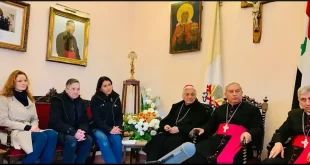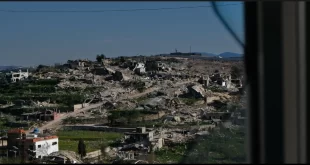July 1, 2017, The Century Foundation – Aron Lund

On Monday evening, the White House released a statement saying U.S. intelligence had “identified potential preparations for another chemical weapons attack” in Syria. If President Bashar al-Assad used chemical weapons, the statement warned, his military would pay a “heavy price.”
The warning was as curious as it was ominous, but it also raises questions about the way the international community has approached the investigations of chemical weapons use in Syria. Specifically, it highlights the fact that international inspectors have so far declined to visit of the Syrian airfield that is at the center of the White House’s claims, feeding into claims from Russia and others about a lack of on-site collection of evidence.
The Shayrat Air Base
According to Major Adrian Rankin-Galloway, a Pentagon spokesperson reached by phone earlier today, the U.S. military had discovered apparent chemical weapons-related activity at Shayrat, a military airfield that the United States previously linked to a suspected nerve gas attack at Khan Sheikhoun on April 4.
“It’s a specific location at the base, a hardened aircraft shelter that we previously struck with missiles after the events in Khan Sheikhoun,” Major Rankin-Galloway told me. “We saw substantial information coming out, particularly within the 24 hour period before the White House issued its statement.”
He would not get into detail about what sort of activities U.S. intelligence had picked up, but given the way the Syrian chemical weapons program is understood to have worked, the Pentagon’s information seems like it may refer to the preparation of binary nerve agents brought to the site from elsewhere.
Bashar al-Assad promised to give up all chemical weapons in 2013 and subsequently handed over 1,300 tons of chemicals to the Organization for the Prohibition of Chemical Weapons (OPCW). The Syrian government has since insisted that it no longer has any chemical arms, but the United States says there is “no doubt” it secretly kept some materials.
Inspectors at OPCW—the intergovernmental implementing body of the Chemical Weapons Convention to which 192 nations belong—have made no determination on whether Assad retained chemical arms, but continue to pursue “unresolved issues” after previously complaining that Syrian authorities were providing implausible information and saying that they could not verify the full extent of Syria’s pre-2013 weapons program.
Asked about U.S. estimates of the situation at Shayrat now, Major Rankin-Galloway seemed cautiously optimistic. “There’s obviously not been a chemical attack,” he said, “so the indications are encouraging that they got the message.”
Contested Inspections
However, Shayrat’s centrality to the U.S. allegations is somewhat problematic, because so far the United States appears to have shown little interest in getting that base scrutinized by outside inspectors.
The Assad regime and its allies have for months been calling on the OPCW to visit Shayrat and see if it can verify the U.S. allegations. Moscow “insists on the necessity to send an [OPCW] team to Khan Sheikhoun and the Shayrat airbase without any delay,” I was told by Russia’s OPCW representative Alexander Shulgin in April.
Immediately after the Khan Sheikhoun attack, Russia and Iran launched a proposal for a new inspections regime in the OPCW Executive Council. Their plan would have rearranged current inspection teams by adding Russian and other members while also explicitly requiring the inspectors to go to Khan Sheikhoun and Shayrat.
However, this plan was soundly defeated in an OPCW Executive Council voteon April 20, with only four other countries supporting the Russian-Iranian plan against twenty-one members that wanted to preserve the present model. Western diplomats tell me that the exact purpose of the Russian-Iranian plan was unclear to them, but they read it as an attempt to stir up confusion, derail ongoing investigations, or, if voted down in the Executive Council—which did indeed happen—use this to delegitimize the OPCW’s future inspections.
OPCW researchers have been investigating alleged chemical attacks in Syria ever since April 2014, operating through a Fact Finding Mission set up by agreement between the Syrian Foreign Ministry and OPCW Director-General Ahmet Üzümcü. Based partly on these investigations, a separate OPCW-UN panel concluded in 2016 that forces loyal to Damascus had committed at least three chlorine attacks, which Assad’s government denies. “These allegations are absolutely false, and they are being used as a political tool to pressure both the Syrian government and Russia,” a Syrian official told me in January 2017.
It is one of these Fact Finding Mission teams that is looking into the Khan Sheikhoun incident. After preliminary investigations that included overseeing autopsies of bodies brought to Turkey, the OPCW concluded that there was “incontrovertible” evidence that a nerve agent such as sarin had been used. A more comprehensive OPCW report is expected tomorrow.
Damascus and its allies now seem to fear that once the UN-OPCW panel starts to look for the guilty party, it will attribute the attack to Bashar al-Assad—who, unsurprisingly, has called the whole affair a “false flag play.”
The Demand for On-Site Inspections
Ever since the international investigations began to zero in on Assad’s forces, Syrian, Russian, and Iranian media outlets and diplomats have attacked the OPCW over its alleged refusal to conduct on-site inspections. After the Khan Sheikhoun attack and the April 20 vote, this campaign has increased in volume and aggressiveness. The OPCW’s Khan Sheikhoun investigation is being portrayed as a tool of a dark, Washington-led conspiracy.
The OPCW’s Khan Sheikhoun investigation is being portrayed as a tool of a dark, Washington-led conspiracy.
Legitimate questions have been raised about the U.S. claims about what happened in Khan Sheikhoun, including about the crater that American authorities say mark the spot where a chemical munition landed. That location seems difficult to square with the reported death toll, which I’m told by one expert would likely be lower, given the wind direction and other issues.
However, most of the Russian-Syrian-Iranian attacks on the OPCW are easy to dismiss as politically motivated mudslinging. The fact that the Russian Foreign Ministry has chosen to base its arguments on notorious conspiracy theoristsdoes not instill confidence in its motives, but it helps whip up a toxic atmosphere of doubts and confusion. “It appears to me as a way to build their case for ‘plausible deniability’ later on,” I was told by a Western diplomat earlier this spring. “They’re planting doubt in advance.”
By contrast, the case of the Shayrat air base is one where the Russian-Syrian-Iranian arguments may be on firmer ground, and where some perceive Western governments as more focused on preserving face than on ensuring a thorough investigation.
Syrian Deputy Foreign Minister Faisal Meqdad sent an official invitation to the OPCW on April 11, encouraging the inspectors to visit both Khan Sheikhoun and Shayrat. Since then, Russia has continued to relentlessly pursue the issue of field visits, citing the failure to visit Khan Sheikhoun and Shayrat as evidence of that the investigation is corrupted.
OPCW Director-General Üzümcü formally requested UN and Syrian government assistance for a mission to Khan Sheikhoun in late April, and attempts to organize a safe visit to the town were ongoing as recently as May 24. However, there seems to be less interest in visiting Shayrat, with several sources telling me the OPCW has decided that it would not be relevant to its mandate, which excludes the identification of perpetrators.
The U.S. government has backed up this view. The OPCW’s fact-finding team is supposed “to investigate chemical weapons use in Syria, not to determine attribution. Therefore it would seem logical that they only go to the area where the strike hit,” I was told by a U.S. State Department official who spoke to me before the recent White House warnings.
Formally, that’s true. But if Syrian authorities agree to welcome the inspectors, there is no evident reason Üzümcü could not dispatch a team to Shayrat—and the relevance of that site to the allegations of chemical weapons attacks in Syria is now undeniable.
Legitimate Safety Issues
The most obvious reason for the OPCW’s cautious attitude to field inspections is surely that Üzümcü fears for his staff’s security. This applies especially in the case of Khan Sheikhoun, which is located in an area of northwestern Syria that is generally off-limits to foreign aid workers and journalists, rife with violent crime, ravaged by air strikes, and divided between rival Islamist groups that sometimes attack each other.
As such, Khan Sheikhoun presents almost insurmountable security challenges to the OPCW. Staffed by scientists, diplomats, and technical experts, the organization was set up to conduct orderly inspections at designated sites, not to perform criminal forensics in an anarchic warzone. But the start of its involvement in Syria in 2013 has forced the OPCW to adapt, sometimes painfully.
The start of its involvement in Syria in 2013 has forced the OPCW to adapt, sometimes painfully.
“It was the first time they put on bullet-proof vests,” says Paul Walker, a veteran disarmament expert with whom I spoke earlier this month. “Since then, the OPCW has started asking inspectors to volunteer for these missions instead of just assigning them, which used to be the case.”
In May 2014, a team of OPCW inspectors en route to Kafr Zita, a town near Khan Sheikhoun that had reported a string of chlorine attacks, was bombed by unknown assailants and then briefly detained by a rebel group as the inspectors fled the scene. All were quickly released on the intervention of another rebel faction, but their brush with death brought a screeching halt to OPCW plans for inspections inside opposition-held territory.
“When something like this happens, the system and the people involved are not going to take that risk again,” says a person associated with the OPCW mission. “But then there are other ways of continuing the investigation, which actually we did.”
Subsequent OPCW investigations of events in rebel-controlled areas have been carried out from Turkey, with Syrian activist groups contracted to bring witnesses and samples to the inspectors. Assad’s allies have attacked these methods, saying the reliance on opposition-linked groups creates a situation ripe for outside manipulation.
While the experts I have spoken to all expressed faith in the integrity and impartiality of the OPCW and its inspection teams, some also cautioned that it will indeed be difficult to draw conclusions from environmental samples or testimony provided in this way, just as it is difficult to rely on material and witnesses put forth by the Syrian government.
However, the OPCW researchers have elaborated on their methodology in successive reports, arguing that although reliance on local actors as go-betweens can taint the evidence collected, sources and samples may also be cross-checked and verified in a variety of ways—which has allowed them to draw at least some conclusions. In short, the researchers argue, site visits are strongly preferred, but a remotely run operation is not useless—and it’s certainly better than calling off the investigation.
Fears of Betrayal
While Khan Sheikhoun would expose the inspectors to risks from all sides, Shayrat is an area under complete regime control. A government escort should be sufficient to ensure inspectors’ security.
However, Western diplomats and people associated with inspection missions in Syria have hinted to me that they fear that the Syrian government or its allies could arrange an accident or lure inspectors into a trap, if they were to get too close to some undesirable truth. One person associated with OPCW inspection missions claims that the Syrian government may even have been involved in staging the May 2014 incident described above. “What does it take for them to call their intelligence services and arrange this?” the person says. “Not much.”
Others have pointed to a different incident in September 2016, when a United Nations and Red Crescent aid convoy traveled into the Aleppo region after being promised safety under an American-Russian deal, but was then pummeled with air strikes that killed fourteen civilian aid workers. UN investigators pointed to Syrian or Russian culpability, though they could not determine whether the attack had been deliberate. A separate UN panel later said it found strong evidence that the killings were “meticulously planned and ruthlessly carried out by the Syrian air force.”
The September 2016 attack still weighs on the mind of many international officials, to whom it represented an outrageous breach of trust. It is possible that the incident has factored into the OPCW’s apparent lack of interest in visiting Shayrat even under army protection.
The Syrian government did not respond to requests for comment.
Problematic Political Optics
Apart from the obvious safety issues and the organizational strain of conducting two high-stakes field visits instead of just one, the political optics of going to Shayrat may be another reason for the OPCW’s hesitancy.
Chemical arms experts tell me that it is unlikely that inspectors will find anything at Shayrat, even if the American reports are true. Chemicals would presumably not be stored at the base, and a swift in-and-out mission to prepare an attack wouldn’t necessarily leave any traces for the inspectors to discover. But even if finding nothing truly means nothing, the Syrian government and its allies would likely present an inconclusive inspection at Shayrat as confirmation of Assad’s innocence.
“I suspect that if a team goes [to Shayrat], there will be nothing chemical weapon-related to find. Then this visit would become another point of contention to the competing narratives at the OPCW Executive Council and UN Security Council,” says John Hart, a chemical weapons expert at the Stockholm International Peace Research Institute (SIPRI) who spoke to me earlier today. But he added that the OPCW’s motivations are likely complex: “There is certainly more granularity to this question if one speaks to those directly involved.”
A visit to Shayrat would also inevitably raise pressure on the OPCW to then make a corresponding visit to “the other side,” meaning Khan Sheikhoun, which may be impossible given the extreme security risks. But if only the government site at Shayrat ends up being inspected, the OPCW will likely find itself even more exposed to Syrian, Iranian, and Russian claims of bias.
“You don’t want to end up in a situation where there are competing stories, but because of the circumstances you can only investigate one but not the other,” I was told in May by Ralf Trapp, a former senior OPCW official and chemical weapons expert.
For Western governments critical of Assad, the expected political blowback may be a factor in their apparent lack of interest in pushing for a mission to Shayrat. A reluctance to start fiddling with the mandates of ongoing investigations clearly plays a part, too. Western officials have expressed irritation with Russia’s attempts to steer the OPCW mission in this direction, arguing that it represents unacceptable interference, and that an investigation of the potential source of the attack at Shayrat would be a job for the separate OPCW-UN mechanism that looks into attribution of responsibility. “We reject attempts by any State Party to pressure the OPCW Director-General or to undermine the impartiality and independence of the OPCW’s investigations,” another State Department official told me today.
But in light of the renewed U.S. accusations of chemical weapons activity at Shayrat, the failure to inspect the base is starting to look problematic.
If security fears are at the root of the OPCW’s apparent unwillingness to visit Shayrat, that should be brought to light and, if possible, addressed. If other concerns, outside pressures, or fears of political smear tactics are involved, this, too, deserves to be brought into the open. If there is genuinely agreement from both the OPCW and the Syrian government, even the issue of the fact-finding mission’s narrow mandate could surely be sidestepped through some creative arrangement, and Shayrat could certainly be visited under the auspices of the OPCW-UN mechanism, which has a more permissive mandate.
The United States has already struck Shayrat with missiles once, and now points to the air base as the potential trigger for another act of war.
The Shayrat air base is now at the center of U.S. claims that the Assad government is illegally hoarding and using nerve gas, and it has become just as central to the government’s defense against those accusations. The United States has already struck Shayrat with missiles once, and now points to the air base as the potential trigger for another act of war.
In these circumstances, if anything at all can be gained from an inspection visit to Shayrat, it seems strange that such a visit would not be attempted—however much Russian or Syrian media may gloat over the likely result of an inconclusive finding.
 Syria Support Movement solidarity with the Syrian people
Syria Support Movement solidarity with the Syrian people




